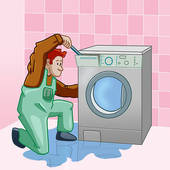Our washing machine broke last week. Oh no! What do we do? Repair or replace?
 This is the third time there has been a major failure, not counting the warranty repairs. Now you might think that three times (plus warranty work) is a bit much for a modern appliance. And you would be right except…the last time there was a major failure was close to 6 years ago and the time before that was one year earlier, for a different part! The first failure didn’t occur until the machine was 8 years old!
This is the third time there has been a major failure, not counting the warranty repairs. Now you might think that three times (plus warranty work) is a bit much for a modern appliance. And you would be right except…the last time there was a major failure was close to 6 years ago and the time before that was one year earlier, for a different part! The first failure didn’t occur until the machine was 8 years old!
We did have a an ongoing problem after the first repair that was finally sorted out after replacing a few components (it turned out that there was a faulty sensor) but, in reality, in 15 years we have only had to replace two controllers, two pumps and that mischievous sensor. I reckon that’s pretty good!
However, last week we had to decide what to do. Repair or replace?
The machine is getting on a bit and modern appliances have a reputation for having short lifetimes due to building down to a price and “planned obsolescence” (a particularly irritating euphemism). We finally got the repair company to give us an indicative, non-binding, “we will not be responsible for any number we give you over the phone” estimate of the possible range of prices that could be in the region of the actual price given that they had not sighted the machine and could not possibly know in advance what the actual problem might be (you know the drill), but they suggested that if we budgeted for between $300 to $400 we would be in the right ballpark.
Now a new machine of a similar size, in fact, the same basic model is still being made, would be not much more than $400 anyway so, we were faced with that, oh so, familiar dilemma. Repair or Replace? Especially when you consider that there would be a minimum call-out fee of $150.
That meant that we could:
- spend up to $400 to get the old machine fixed and take the risk that there could be enough wrong with it (eg bearing damage) to make it effectively non-repairable or that it could fail very quickly, or
- simply purchase a new machine for a little more than $400 and be done with it.
Of course, if we picked option 1 and it turned out that the machine could not be repaired we would be out of pocket $150 on top of the purchase price for a new one!
Aaaaarrrrghh! What do we do? Repair or Replace?
We talked about it for a while, gnashed our teeth, paced the floor, stared silently into space and then I said, “I really have a problem with throwing out, what seems to be, an otherwise perfectly good machine, I mean the motor is a direct drive and super reliable, the actual body looks in really good condition, the control panel is getting very worn but the buttons all seem to be working okay and it wasn’t making any strange grinding noises or anything before it broke down, was it?”
“No”, she said, “it has been running fine until last night when it slowed right down and then wouldn’t start and just started making that humming noise”.
“Hmmm”, I replied, “I reckon, we take risk of blowing the $150 and get them in to fix it”.
“I agree”, she said, “I don’t like to idea of throwing it away either!”
So we arranged for the repairer to come in and fix it and, that was that!
Or was it…?
 The repairer came in and had a quick look, turned to me and said, “This looks like it might be a expensive repair and this is a very old machine, you know you could get new machine for around the same price. If there are other problems like the bearings for instance, it won’t be worth fixing. Are you sure you want to go ahead?”
The repairer came in and had a quick look, turned to me and said, “This looks like it might be a expensive repair and this is a very old machine, you know you could get new machine for around the same price. If there are other problems like the bearings for instance, it won’t be worth fixing. Are you sure you want to go ahead?”
Oh no! Again? Really? Repair or Replace?
I pointed out that we had already spent $150 when he walked through the door and he agreed that apart from the fault(s) or the bearings, which he couldn’t test until it was running, the machine was in very good condition. So we agreed to have him repair it.
So, one controller and a pump plus about 25 minutes of his time and $388 later, we had a working washing machine! Yay!
He said that, apart from the worn control panel, the machine appeared to be as good as new, so that is good news. This time, at least, we made the right call and the machine should give us many years of service.
In any case, I’m happy that we had it repaired, even if it had cost us the same or maybe even a bit more I would still prefer to have had it fixed. Eventually, however, it will, like most things, be non-repairable and we will have to replace it. But how will we know? Is there a foolproof way of deciding that without spending time and money on the decision? I don’t think so.
So next time it breaks down, what will we do?
Repair or Replace?

Hi Mick,
I suppose your next decision point will be the time that the manufacturer stops making the parts that you need.
That would be the only time I would replace it.
Gav
That’s probably true Gav…
…but maybe by then , I might be able to 3D print the replacement parts myself 🙂
(see my earlier post http://www.sixgorillas.com/2013/05/the-desktop-manufacturing-plant/)
Cheers